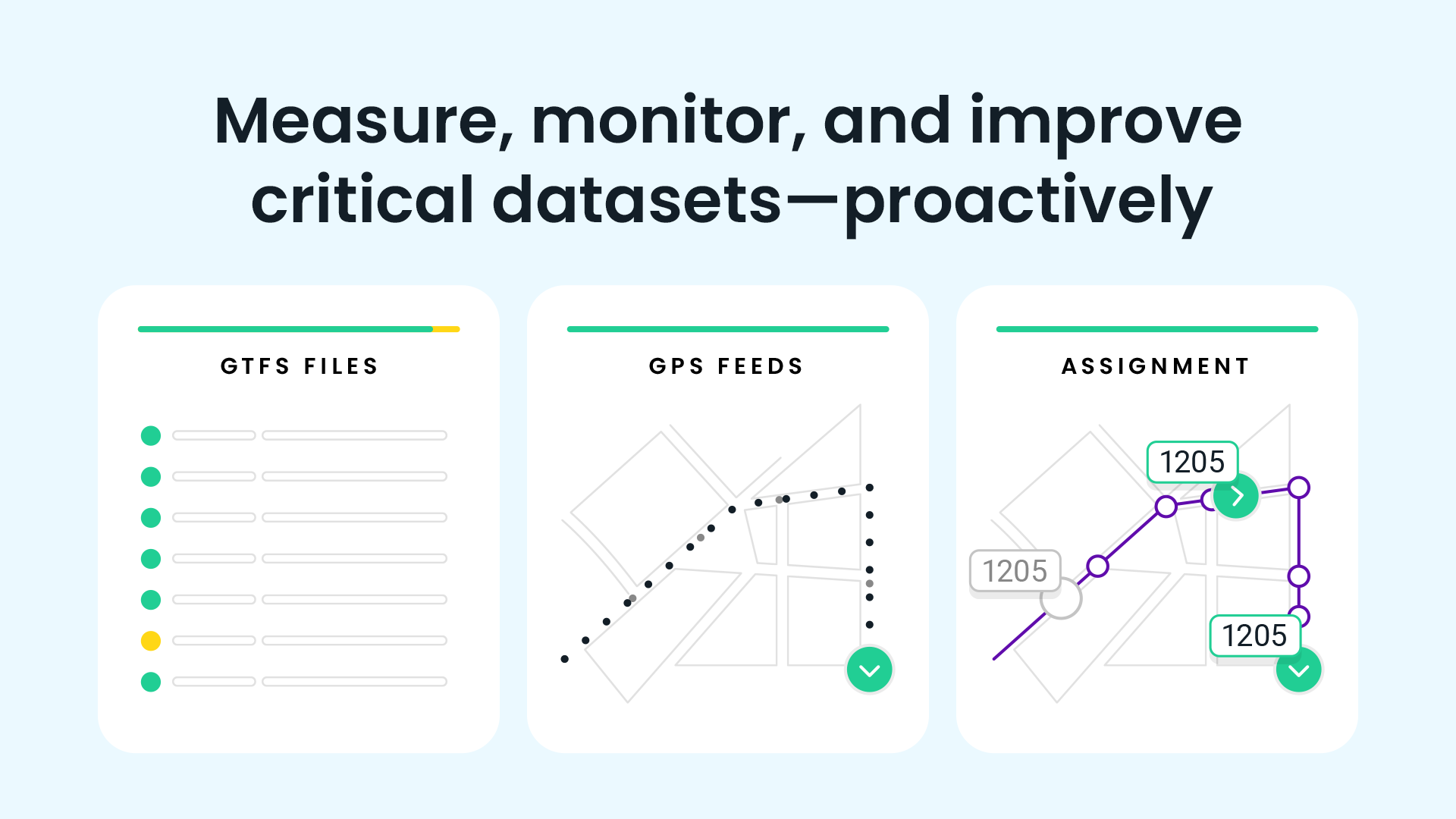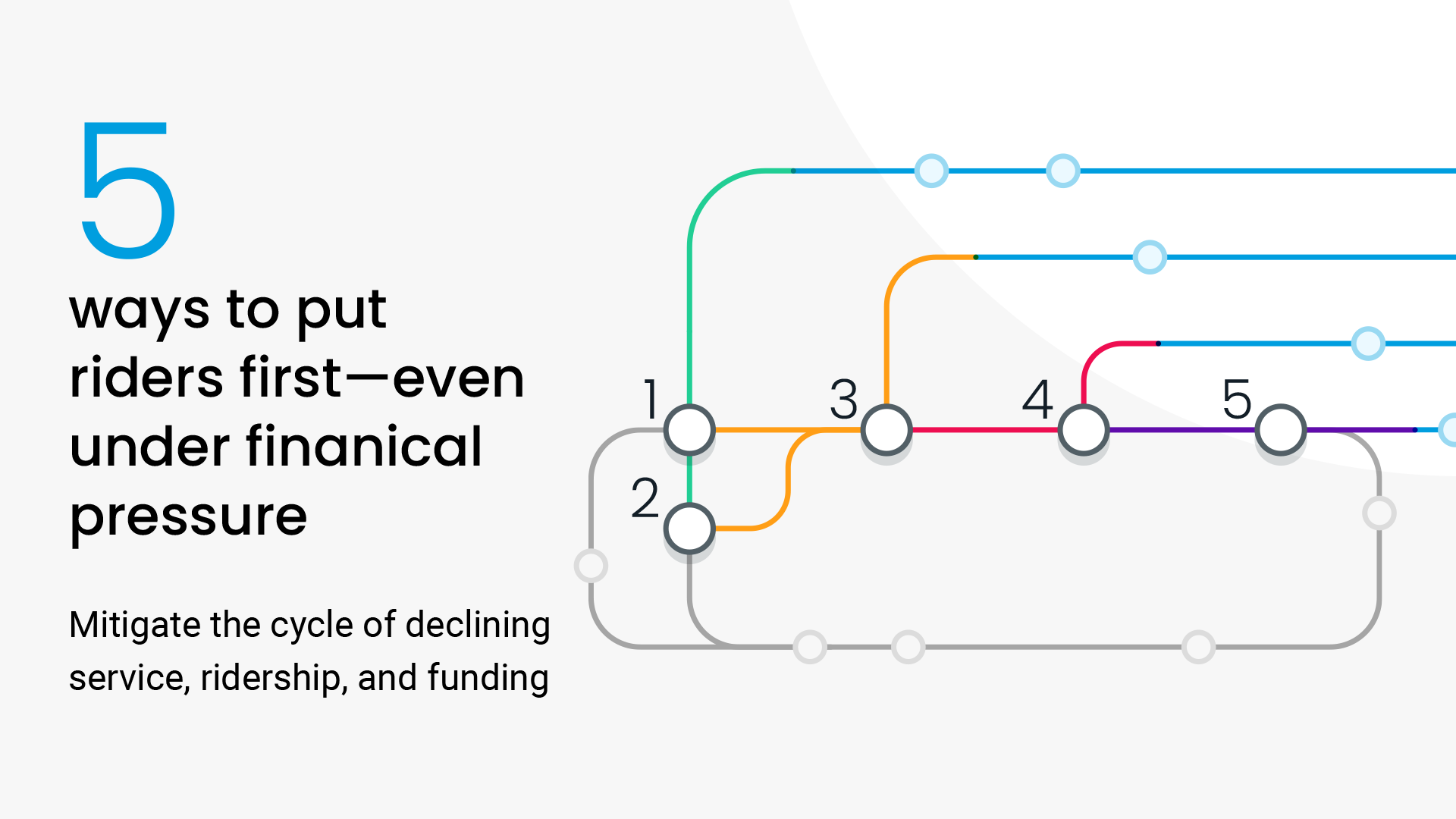
March 30, 2021
Building Transit Back Better in a Post-Pandemic World

March 30, 2021
Building Transit Back Better in a Post-Pandemic World
March 30, 2021
Building Transit Back Better in a Post-Pandemic World
With Covid-19 vaccinations ramping up nationally, many Americans are beginning to hope life will soon return to “normal.” However, for many public transit agencies a return to the 2019 status quo could mean a return to declining ridership, stretched budgets, and sub-optimal on-time performance. Fortunately, a post-pandemic world presents new opportunities for agencies to establish a “new normal.” On March 10th, Congress approved the American Rescue Plan Act of 2021, which allocates $30.5 billion of emergency public transit funding as part of a larger national effort to “Build Back Better” after the pandemic. But what will Build Back Better mean for the future of public transit?
1. Fast, frequent, and reliable service
As noted in the 2021 State of Public Transit, 95% of surveyed transit professionals reported ridership declines in 2020, and 68% of those surveyed reported ridership numbers plummeting by more than 50%. The key to earning rider trust and confidence post-pandemic will be mastering the fundamentals: fast, frequent, and reliable service. This is no easy feat under any circumstances, but it is especially challenging with limited funding. The 2021 State of Public Transit also reports that 81% of surveyed transit professionals identified budget as their top concern. Even with an injection of new federal funding, transit professionals everywhere have been and will continue to be doing more with less.
Fast, frequent, and reliable transit service should be the top investment priorities for building back better. This is what riders want, period. A growing body of research suggests that higher frequency and better travel times strongly correlate with increased ridership, especially bus ridership. Unreliable transit results in decreased ridership. While expanding transit service requires additional funding, leveraging high-quality data analytics can help transit agencies more effectively target where to spend money to optimize service.
How to build it:
Faster bus service can be achieved through large-scale capital improvement projects, such as dedicated bus lanes, or by smaller, cost-effective improvements like transit signal priority, adjusting stop spacing, and all-door boarding. All of these projects, big or small, can benefit from accessible, high-quality data to identify where to spend money, whether it’s identifying which corridor to prioritize for TSP, or pinpointing appropriate bus stops for consolidation.
Increasing transit frequency requires deploying more vehicles, but ultimately, high frequency routes are only as good as their headways. Switching from a schedule adherence to headway management is a cost-effective way for agencies to ensure their transit investments translate to reliable service for riders. SFMTA Director, Jeffrey Tumlin, credits headway management with making SFMuni’s service more reliable than ever.
2. Dynamic service for evolving travel patterns
In 2020, millions of workers stopped commuting to downtown offices and switched to working remotely. This trend may endure, with some studies estimating that over 25% of the workforce will continue to work remotely even after the pandemic. Downtowns may decentralize, peak service hours might become less important, and large, expensive cities might shrink as populations move to less crowded areas. Real estate investors are already flocking to smaller, suburban markets in anticipation of a surge in transplants, particularly into the Midwest and Southeast. Ridership patterns are changing, and no one can say with certainty where they’ll land in the next 5 to 10 years. Transit agencies must be able to plan and adapt to new and evolving travel and commuting needs.
How to build it:
Transit agencies are accustomed to planning service based on the “supply side” of the transit equation -- that is, increasing or decreasing transit service based on available budget within the agency. The “demand side”-- ridership -- is often a missing or inaccurate part of the equation. However, with advancements in big data technology, agencies no longer have to invest in expensive and imperfect models to guess at ridership patterns. The “demand side” of the equation will soon be within grasp too.
In practice, this points to a two-pronged approach.
First, agencies should invest in ways to proactively anticipate changes to ridership trends. With real-time ridership data, agencies can more precisely pinpoint which neighborhoods, corridors, and job centers are the best candidates for limited transit resources.
Second, agencies should equip themselves with tools that allow their teams to stay nimble when demand quickly shifts in unexpected ways. For example, investing in strong fixed-route bus systems and pairing it with on-demand service allows agencies to be flexible and cost-effective in delivering dynamic, efficient service. By continuing to innovate with how new technology can complement core transit service, agencies can remain agile as we reach a new equilibrium in the post-pandemic world.
3. Agility and resilience during times of crisis
During the pandemic, transit professionals changed schedules twice as often in 2020 compared with 2019. This supports a key lesson for transit agencies from the pandemic, agility is key in times of crisis.
The Covid-19 pandemic will not be the last crisis to disrupt transit. In fact, we may already be witnessing the impacts of another crisis: climate change. Climate change has been linked to recent unexpected severe weather events such as more hurricanes, and winter storms, including the unprecedented snowstorm that hit Texas in February. The ability to remain agile through fast, real-time service adjustments will increase agency resilience and retain rider trust in times of crisis.
While ridership declined by up to 50% in some areas during the pandemic, the flip side is that half of riders continued to rely on transit. Crises and natural disasters disproportionately impact the most vulnerable communities. These are often the same people that are most dependent on transit. Building back transit with greater resilience will not only benefit these riders, they will benefit the entire community. As transportation and equity advocate, Tamika Butler, observed:
"The pandemic has really put the conversation around who is essential into sharp focus. So many of the people we rely on day-to-day are still going to work... If they’re still showing up, and they’re dependent on transit, then we’re a transit-dependent country."
How to build it:
Agencies have spent the last 12 months becoming experts in managing the unpredictable. But there’s still a lot of room for improvement. Despite their herculean efforts to keep transit running during the pandemic, transit professionals gave their Covid-19 response a C+ on average. Their biggest self-criticism? 60% of transit professionals say they wished they had a better system for alerting riders of service changes.
Agility boils down to two equally important elements: being able to quickly make ad hoc service adjustments AND automatically keeping riders informed when the changes go into effect. Agencies must invest in tools and processes that make it easy for them to do both.
The reality is that disruptive events are already becoming the new normal. Even on a smaller scale, transit agencies need to respond quickly to unexpected events. We owe our communities clear communication and reliable transit service regardless of what unexpected events the future holds.
Conclusion
The past year has been truly devastating to our communities -- especially the most vulnerable. The American Rescue Plan package offers us an opportunity to take stock of the lessons learned from the pandemic, and to work together to build back better with more frequent, agile, and resilient public transit.
In the wake of the pandemic, expect agency management to be open to taking bold action. Now is the time to seize the moment and by building better travel times, frequency, and reliability. Your riders will thank you for it.
Request a demo
The rich text element allows you to create and format headings, paragraphs, blockquotes, images, and video all in one place instead of having to add and format them individually. Just double-click and easily create content.
Last Name, Agency

What’s a Rich Text element?
What’s a Rich Text element?
What’s a Rich Text element?
What’s a Rich Text element?
What’s a Rich Text element?
The rich text element allows you to create and format headings, paragraphs, blockquotes, images, and video all in one place instead of having to add and format them individually. Just double-click and easily create content.
Last Name, Agency
Static and dynamic content editing
A rich text element can be used with static or dynamic content. For static content, just drop it into any page and begin editing. For dynamic content, add a rich text field to any collection and then connect a rich text element to that field in the settings panel. Voila!
How to customize formatting for each rich text
Headings, paragraphs, blockquotes, figures, images, and figure captions can all be styled after a class is added to the rich text element using the "When inside of" nested selector system.
- text goes here
- text goes here
- text goes here
- text goes here
- text goes here
- text goes here









